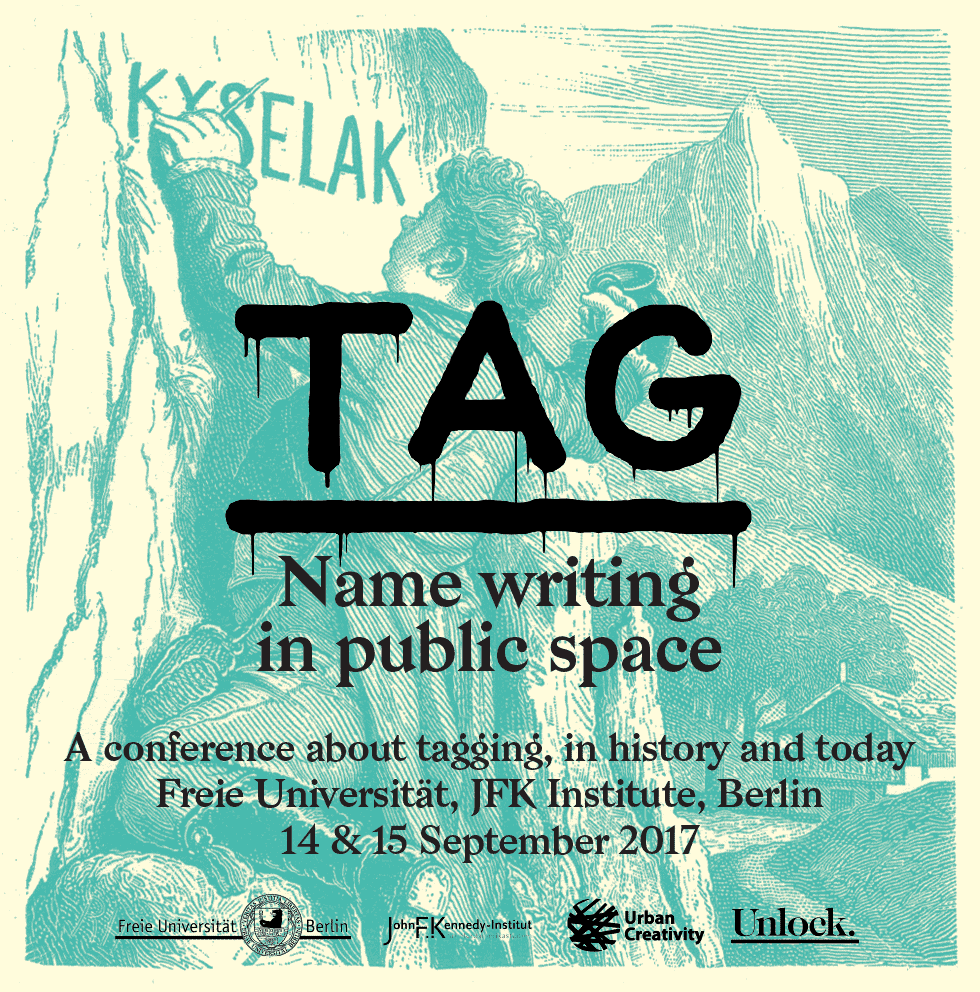Call for Papers - TAG Conference
TAG Conference Flyer
Image Credit: Illustration extracted from Die Reise des Herrn Kyselack, E. M. Vacano 1886.
Written signatures, or tags, are the central element of graffiti culture, and the most widely practiced form of public art. Yet tagging has rarely been the subject of serious examination. The Tag Conference is a first attempt to conceptually frame contemporary tagging, and to study it alongside its abundant but largely ignored historical antecedents.
The Tag Conference provides space for the discussion of a wide range of underexplored topics, such as the study of tagging as a form of calligraphy, tagging’s role as a device for understanding the environment, the history and folklore of past and present tagging cultures, and the relation of tagging with other forms of art in public space.
Informal name writing in public spaces is a time-honored practice, probably as old as writing itself. From children and anonymous laborers to famous authors, politicians or archaeologists, people of all kind have felt the urge to mark their passing through a particular place and time by leaving a personal trace for other people to see.
This practice has played a particularly visible role in different points in history, such as Ancient Rome and Romantic Europe. It has served as a cartographic tool and as a way to keep trace of people in unexplored landscapes. It has been used as a symbolic weapon in wars. And, in the last century, it has acquired unprecedented intensity and has become the central feature of several full-fledged folk cultures throughout the globe.
The most sophisticated of these cultures is the graffiti tradition that developed in the subways of New York City during the 1970s and has later become an expected part of the landscape of most cities worldwide. By influence of this tradition, name writing is today generally referred to with the slang term “tagging”.
The Tag Conference provides a space for discussion about tagging, about its nature, its meaning and its history, and about the diverse tagging traditions and cultures that exist and have existed. The conference is open to anthropologists, art historians, archaeologists, philosophers, geographers, urbanists, calligraphers, artists and other intellectuals with an interest in the field.
The Tag Conference welcomes presentations about a range of topics including, but not limited to, the following:
- Tagging cultures: Theoretical, aesthetic, historical or anthropological enquiries into different tagging cultures, such as the following: New York graffiti culture and its reinterpretations throughout the world, in particular its calligraphic component (the “handstyle”). The pixação culture of Brazil. The flechero culture of Madrid. The ganchos culture of Monterrey. The punk tagging culture of 1970’s Amsterdam. North America’s hobo graffiti or boxcar art. The cholo tagging culture of LA street gangs.
- Tagging as a calligraphic practice: The calligraphic styles, graphic references and writing tools and materials of different tagging cultures. How references, tools and materials give shape to calligraphic styles. The design and building of customized and DIY writing tools and materials as a way to solve calligraphic problems related to surface and reach.
- Tagging as a spatial and time-based practice: The series of tags as a network spread through space and time. The relation of tagging, architecture and social control. Tagging as a way for the individual to relate to the built environment. Tagging as a tool for control of the territory for street gangs.
- Tagging as cartographic tool: El Morro, Signature Rock and other traditional tagging sites in the North American colonial routes. Daniel Boone and the tagging of the North American pioneers. Other related cases.
- Tagging as a rite of passage: The tagging tradition of the Spanish quintos. The vítores tradition of graduates in Spanish universities in the XIX century and before. Other related traditions.
- Tagging as a marking of a sustained relation to a place: Tagging in military bases and places of stationing. Tagging in prisons. Tagging in the workplace.
- Tagging as symbolic weapon in wars: Notorious cases such as the tomb of Tutankhamun or the Reichstag in Berlin. The case of “Kilroy was here”. Other related cases.
- The relation of tagging with other forms of public graphic identity: Tagging as a reflection of advertising and of other forms of official name-writing in public space. Baudrillard’s reading of tagging as semiological warfare.
- Tagging in history:
- Tagging in Ancient Rome.
- Tagging on Roman archaeological findings during the Renaissance. Notorious cases such as the tagging of the Domus Aurea by various Renaissance masters, or the tagging of the catacombs by pioneer archaeologist Antonio Bossio. Other related cases.
- Tagging in the Romantic period: Tagging as a part of Romantic tourism. Lord Byron and other prolific Romantic taggers. Kyselak, the most notorious tagger of the Romantic period.
- Name writing personalities of the XX Century: Peter-Ernst Eiffe, Oz, Arthur Stace “Eternity”, Tsang Tsou Choi, Toniolo, Pray, Melina Riccio and other related personalities.
- Name writing with images: Leaving personal traces using images instead of a written name, from street art “bombing” (stencils, stickers, paste-ups) to the paint patches of “graffiti vigilantes”. How these practices relate to tagging.
Abstract submission
The submission deadline has ended. Sorry.Send abstracts to tag.conference.berlin@gmail.com
Abstracts must be under 1500 characters long and include 3 to 6 keywords. Abstracts must be written in English, and presentations delivered in English. Presentations should be no longer than 20 minutes.
The list of accepted abstracts will be communicated in June 2017.
Participation in the conference is free. The organization cannot cover any expenses for presenters. Authors lacking the financial support for attending the conference in person may be eligible to present via videoconference.
Tag welcomes the participation of non-scholars, and will consider any alternative presentational format such as panel debates, artist discussions or video screenings. All lectures are free and open to the public.
Executive committee
Edward Birzin – JFK Institute, Freie Universität
Javier Abarca – independent researcher





